Before Kimberly Clark founded Thoroughbred Placement Resources, Inc., a nationally certified charity, she spent decades training racehorses and ex-racehorses. And among the many lessons learned was how to take care of their mouths, and to be sensitive to their individual shapes.
In this week’s Clubhouse Q&A, Clark continues the discussion of bits, and how to find the right one for your OTTB.
Q: What is your background with horses?
I galloped, trained and owned Thoroughbred racehorses since the late 80’s in Maryland, Pennsylvania, Virginia, West Virginia, Delaware, New Jersey and Florida. In 2007, I began to re-home retiring Thoroughbred racehorses, eventually creating what is now Thoroughbred Placement Resources, Inc. a 501(c)(3) charity. We have an average of 30 horses come through Leighton Farm each year for retraining. I have enlisted the teaching of Jim Wofford, Elizabeth Madlener and David Loman to create my very successful OTTB retraining program. I have even written a book on this subject which can be found on the www.goodhorse.org website. I add to it regularly.
Q: You have a wealth of experiences working with horses. Please describe how you determine the right bit for each horse. What are some of the guidelines you use?
I think it’s important to first identify why most racehorses lay on the bit. In show/pleasure riding the horse is trained to carry the rider. He is conditioned to move from the hind end forward and find balance on all four legs (corners). That is the “tool” in his tool box to use when he has a balance issue. When a horse carries himself on all four corners, he is balanced without the use of momentum, off his forehand and therefore, has a lighter connection with the bit.
Racehorses find their balance through momentum. Think of riding a bike, when you slow down, at some point you have to put your feet down to keep it upright, because of the loss of momentum.
Why do racehorses run on the forehand? Simple. They are faster when they go that way. All horses are naturally forehanded, but training to carry the rider changes the way they travel. The job of the racehorse is not to carry the rider; it’s the rider’s job to stay out of the horse’s way so he can run.
Forehanded travel is correct for Thoroughbred racehorses. They have been physically and muscularly developed in this way. The good news is that Thoroughbreds are so athletic that they are not difficult to retrain or redevelop to carry themselves off the forehand with time and proper training.
When a racehorse or even a green riding horse loses his balance he becomes heavy on the bit and many times will increase his speed to find the momentum to stay upright. A horse off the track will normally speed up on small circles, and after jumps. This is because the new job is challenging his balance. I believe that many riders new to ex-racers mistake this as the horse attempting to run off.
It’s not enough to do 20-meter circles with the retired racehorse. You have to show him how to do it and then build his strength to go in this new manner.
How does a horse’s individual mouth determine what is used?
It’s important to realize that as the horse progresses in his training the “right” bit can change.
At Leighton Farm, the first thing we do is to have the dentist come out, evaluate the horse’s teeth and mouth and do any dental work that is needed. No bit will be comfortable if the horse is in need of the dentist. We usually start new horses in a fat, metal egg butt snaffle.
If the horse displays any mistrust of the bit or mouth problems, we go directly to a Nathe bit as a sort of “olive branch.” In most cases, this bit will not be used permanently, only until the horse trusts the bit or until we identify and remedy the mouth problem.
It’s important when selecting a bit for a horse that you consider the way the individual horse’s mouth is shaped. Some have low pallets, so a straight or even a French link bit is more comfortable for this particular type of mouth. Don’t forget to get the correct width of bit for each horse.
You can try bits you already have to determine this or you can obtain a measuring device that helps determine bit width. You must also consider the thickness. I have encountered horses with small corners of the mouth and/or low pallets and although a fat bit is generally considered to be less severe, it is in fact very severe to these horses.
You should also consider the shape of the bars of the mouth. I was sent a horse to train who was very untrusting of the bit. She was a 16-year-old Thoroughbred mare. Her rider didn’t seem to have hands harsh enough to cause this sort of reaction to the bit.
I put a Nathe bit on her and she went like a dream after a very short amount of time. Upon further investigation of her mouth, I found that the bars of her mouth were pointed, not flat like most horses. This horse had likely spent most of her life trying to communicate that bits hurt her mouth. We eventually went to a soft rubber, egg butt bit, which is better for Dressage.
Q: Which bits have worked best with some of your OTTB’s and why?
I honestly don’t have just one bit that works. I can go through two of the horses I have in training at the moment and tell you the bit they have and why I am using it. Sand Save, is an 11-year-old Thoroughbred gelding, eventer/jumper.
This horse came to me 4 years ago with tons of anxiety about everything, incredible jumping ability and very behind the bit.
He was not trusting of the bit at all and lacked any sort of normal connection to it. Through the years I’ve tried different bits and the full story is too long to cover, and ongoing so I’ll give an overview.
I started him in the Nathe bit and jumped up to 3’6” courses in it. He gained much confidence and it was suggested to me that I find the “next step.” I went to the egg butt French link due to his low pallet. I even had a rubber one made for him.
He accepted this bit and went well enough in it to win in dressage, which he had never done before. However, the corners of his mouth are very tight and it caused a painful crack in the corner of his mouth. This must have been a lifelong problem for this horse because he has a buildup of scar tissue on the inside of the corners of his mouth. Scar tissue has no blood supply and cracks open easier than regular tissue.
You could not detect this problem from the outside of his mouth and it was intermittent so we discovered it just by looking in his mouth at the right time to find it. Upon learning this, I went to a hackamore, which he loves, but does begin to lay on as I ride him. I can’t properly supple his pole to soften him with it, but it gives his mouth a break and builds his confidence.
His mouth now healed, he goes in a straight soft rubber bit with D’s rather than loose rings like the Nathe bit.
Another OTTB, Wild Lies, is a 14-year-old gelding in jumper/dressage.
This guy raced until the age of nine, and his last track was Finger Lakes.
When I got him, Willie/Wild Lies loved to lie on the bit in addition to gripping it. This is probably the sort of horse that worries riders new to ex-racers. What many people don’t realize is a horse like this is actually responsive to the bit, but just lays heavily on it. It’s intimidating to someone who has never galloped racehorses.
In Willie’s case, he believed it was the right way to go, after all he had done it that way for seven years and no one ever complained. And, more importantly, he wasn’t strong enough to carry himself from behind for more than a few steps. A horse off the track needs to be strengthened both behind and in his back before he is able to lift the front end and come off the forehand, producing the lightness that show and pleasure rider’s desire.
He is currently schooling Second Level Dressage and competing First Level under the coaching of Elizabeth Madlener. He is also jumping 4’ courses and competing 3’ courses under the coaching of Jim Wofford and David Loman. He competes in Dressage in a loose ring snaffle and jumps in a Myler full cheek with hooks which provide a mild gag action.
For dressage the loose ring snaffle was the choice because horses are less likely to lie on a loose ring than an egg butt, D or more stable bit. For jumping, while we didn’t want a severe bit, we did want something with a bit more leverage such as the Myler Full Cheek due to the fact that each jump upsets the balance of the horse and since Willie is a former racehorse, he is much more likely to recover his balance by going on the forehand than by shifting his weight back— at this stage in his training.
What is your experience with gadget bits?
Wild Lies and I went through a period of about four months where we experimented with different bits to get him to stop pulling.
I’d like to interject that Elizabeth Madlener told me then that when he was strong enough, this would not be an issue and she was right. Jimmy suggested a cherry roller. It worked great for a while, and I was sure it was the bit for Willie and me, but in short order he learned to lay on it.
I liked this bit because it didn’t look too terribly weird. Coming from racing, these gadget bits worry me. We next went to a slow twist snaffle. Again, not too different from a regular Eggbutt snaffle, but evidently not different enough.
Willie had no problem lying on that bit. Then we tried the bit he is in now and it too, worked great for a while, but then he started to lie on it.
David Loman next gave me a Segunda to try. This thing worked like a charm for the laying and gripping problems. The horse’s tongue goes through the port and it prevents the horse from gripping the bit. You better have good hands with this bit. One thing you need to consider when you put a bit in the horse’s mouth to prevent him from laying on it is that you are also preventing him from having what is to the horse a comfortable connection to the bit.
In Willie’s case, it wasn’t long before he decided he could not jump in this bit. Knowing what I know now, I honestly don’t think he was strong enough to do what I was asking (use his back and rear end to that degree) and the real answer was in developing him physically before asking him to stay off the forehand all the time. I went back to the loose ring snaffle we had used previously and that I still Dressage him in. When we started doing 4’, we moved to the Myler with the hooks for a bit more control and he has been lovely.
I have learned that the answer isn’t really in the bit with Willie as much as it is in using more leg to generate more activity behind. The more I ride him with my leg and the stronger he becomes, the lighter he gets.
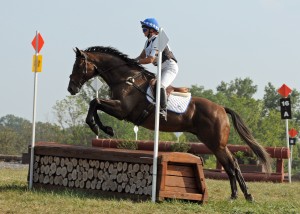
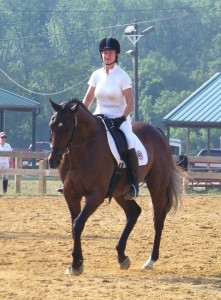

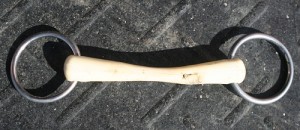
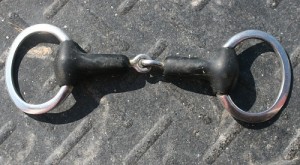
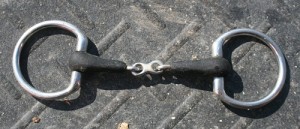

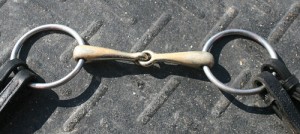


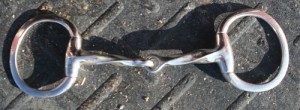
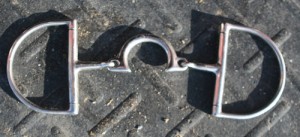


If I understand you correctly you are asking about his curling behind the bit when you trot him in hand? Most likely this is because when racing, we trot horses in hand for two reasons. Once for lameness exam and the other to trot for the vet before a race. Many horses take the second opportunity to show off. This is their day. They are sharp and ready to race and as soon as they come off the van, they are trotted by the vet for a soundness check. Many dance, play and put on a show.
For riding horses who are behind the bit. You’ve got to have a bit they are comfortable with, but in order to get them out in front of you, it has to come from behind. When they go behind the bit, you’ve got to use leg to get them out in front of you and then provide a stable, supple place for them to go. If they are backed off the bit or uncomfortable with it in some way, they are much more likely to dwell behind the bit.
On the bit spacer problem, I would have to see it to answer accurately. In general, I can say that, Lucinda Green uses Latex in many cases to “rubberize” a bit. I don’t know if that would work in this particular case or not.
Kim,
I have a rescued OTTB that is in the D-ring straight, soft bit you mentioned. When I trot in-hand he loves to curl up, rather than lift from C7. He has plenty of muscle accumulated from 3 years of slow, classical training and hilly turnout. Thoughts?
I first started him on a Loose ring French Link but foolishly removed the old rubber spacers and I can not get the new ones on!! Suggestions?
Thanks,
Dawn
This is where I got the rubber french link. I had a time finding a place to get it. I could find examples of it on the internet but not where to buy it until I found abitspecial. They were really great to deal with.
http://www.abitspecial.com/eggbutts.html
Please share where you got the Rubber Eggbutt French Link bit.